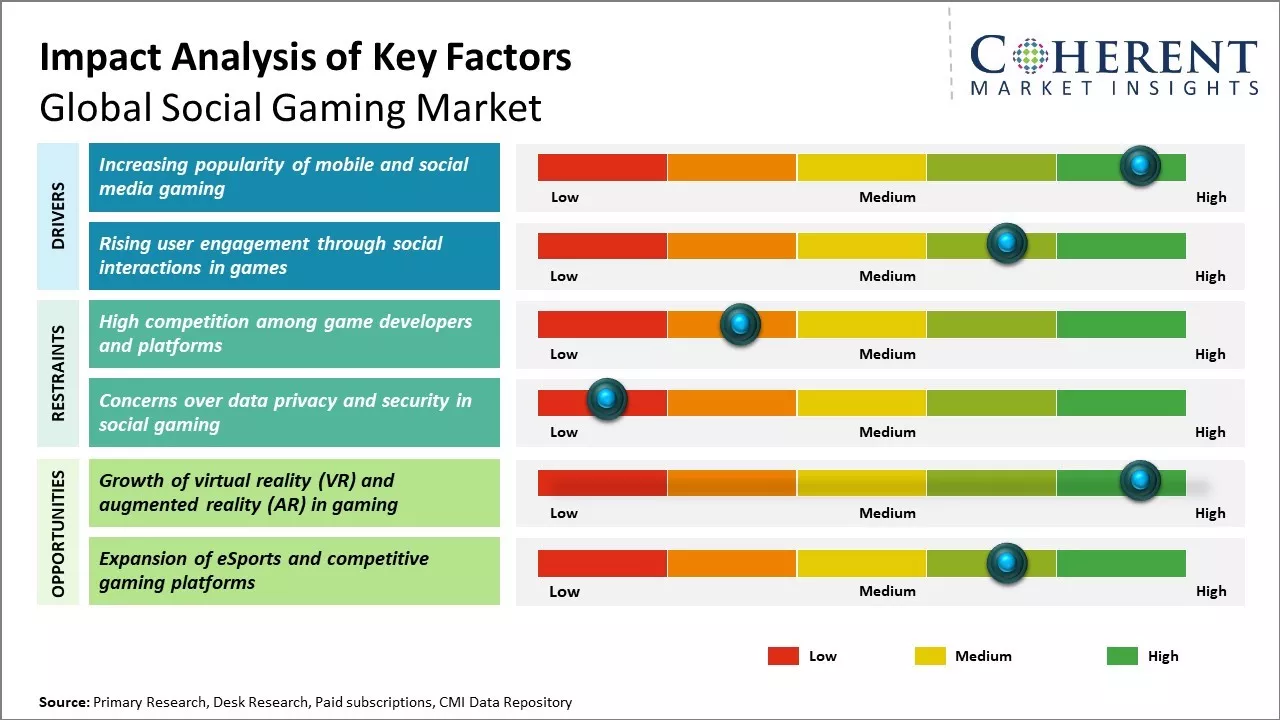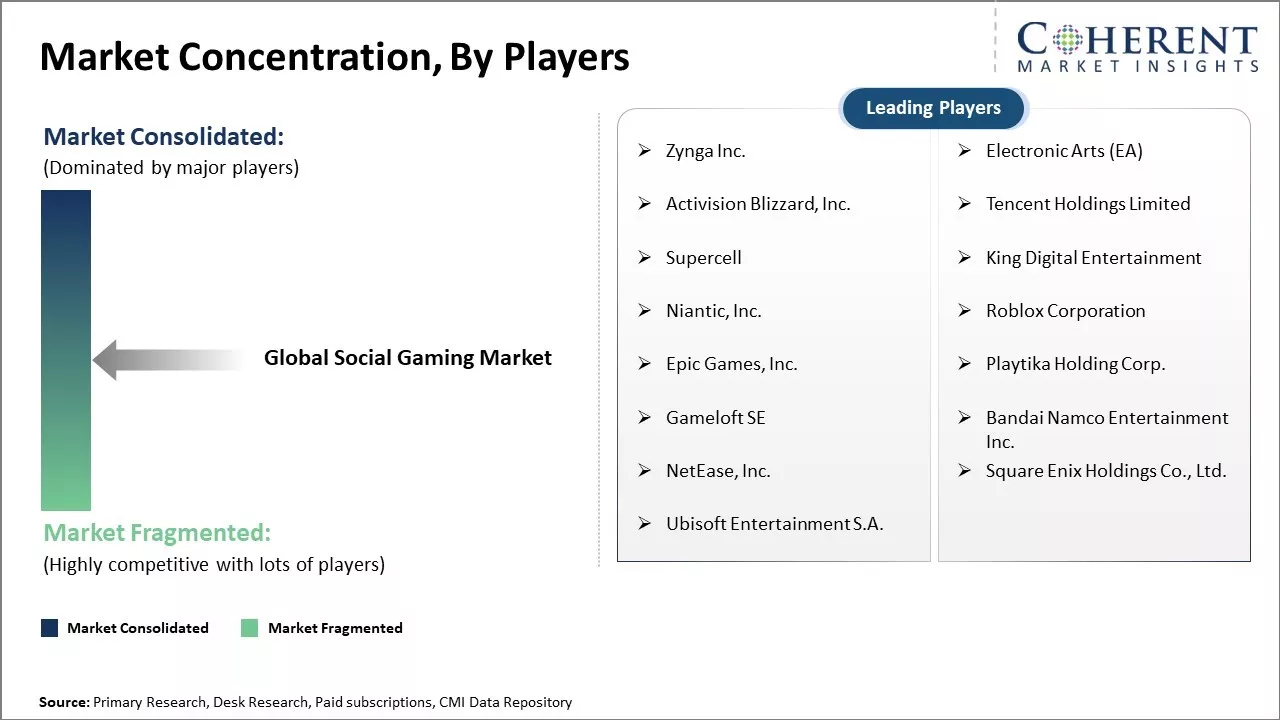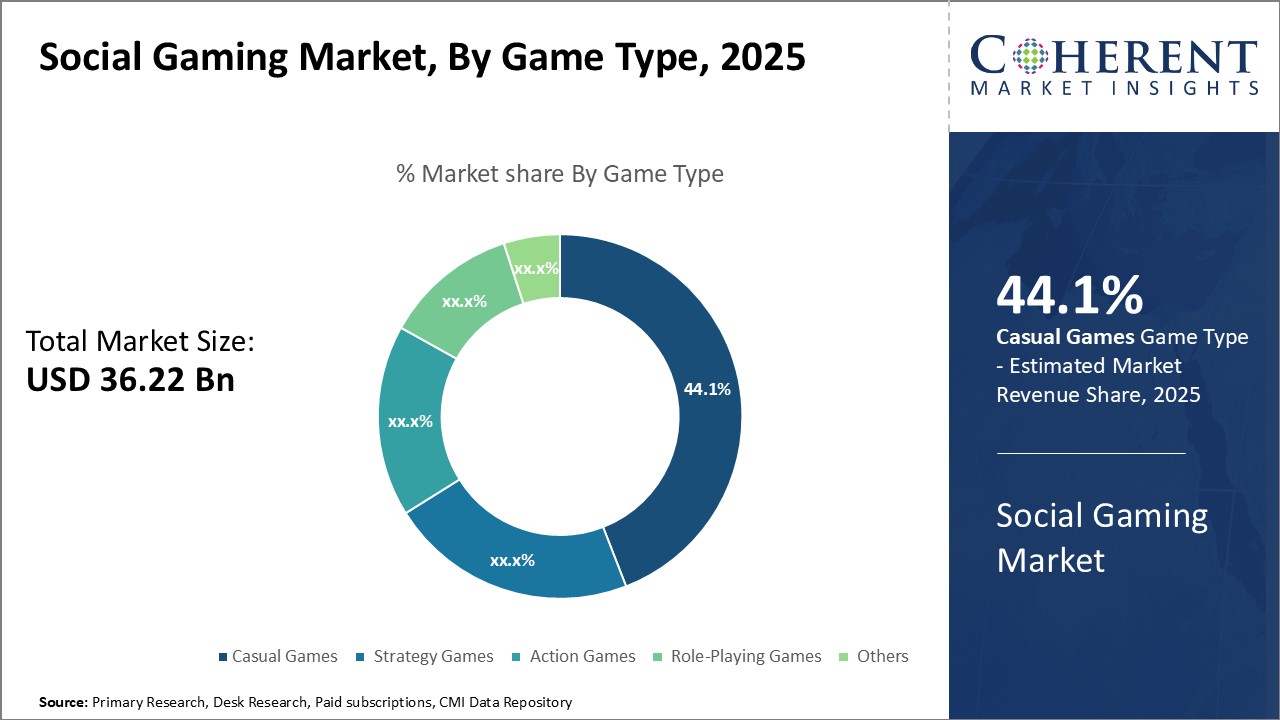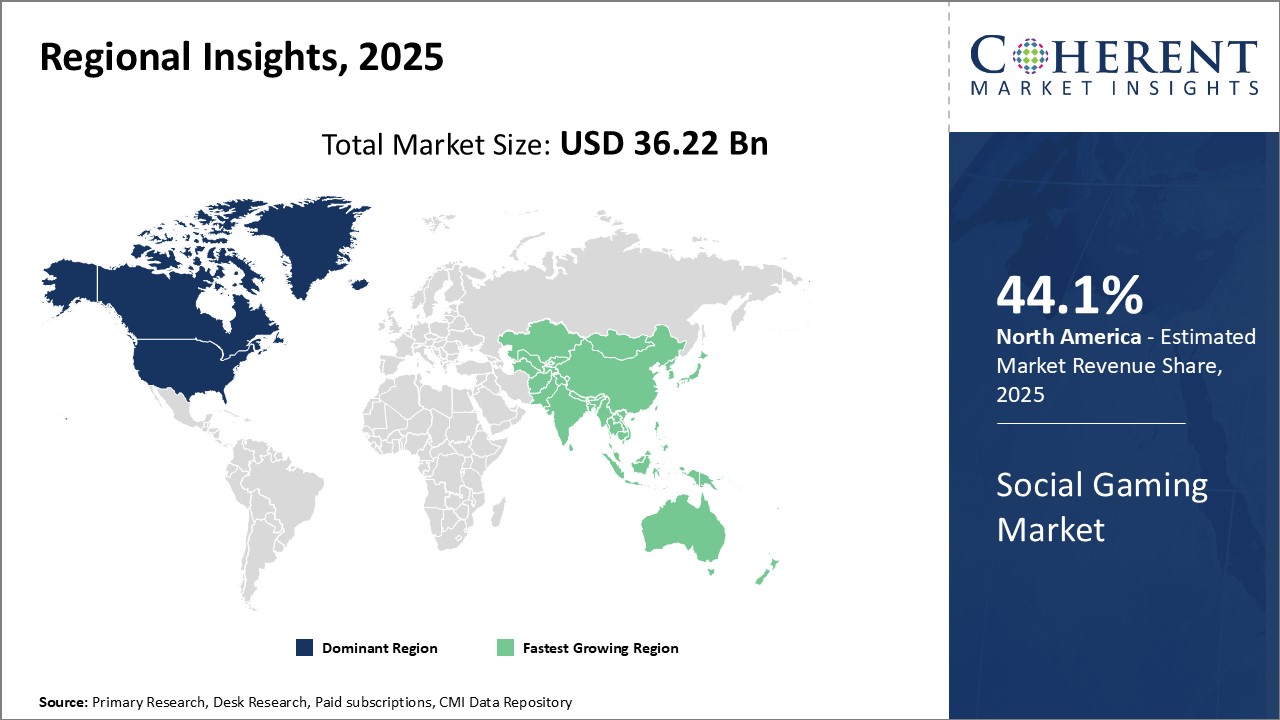Global social gaming market is estimated to be valued at US$ 31.06 Bn in 2024 and is expected to reach US$ 89.74 Bn by 2031, exhibiting a compound annual growth rate (CAGR) of 16.4% from 2024 to 2031.

Discover market dynamics shaping the industry: Request sample copy
The Global Social Gaming Market growth is driven by rising internet and smartphone penetration worldwide. Increased time spent online and preference for casual gaming on social media platforms can drive the social gaming market growth. Market players are focusing on introducing innovative gaming formats and monetization strategies to engage users for longer periods.
Market Driver - Increasing popularity of mobile and social media gaming
Global Social Gaming Market has witnessed growth due to widespread adoption of smartphones and tablets across the world. With powerful capabilities of mobile devices that enable graphics-rich, immersive gaming experiences on- the-go, mobile gaming has become a dominant segment within online gaming space. The ability to easily connect with friends through social media platforms has propelled the popularity of social gaming, where people can play and collaborate with others online.
Mobile games offer highly polished, console-like gaming that was not possible on phones. Blockbuster franchises like Pokémon Go and Candy Crush Saga have achieved mass appeal and shown the commercial potential of mobile formats. Their success underscores how mobile and social features can effectively converge to create engaging gameplay. With mobile internet connectivity becoming ubiquitous, people now have opportunities to fill idle moments with quick mobile games anytime, anywhere. This has translated into significant times spent in-game on phones each day. Meanwhile, social elements let players leverage their network of real-world connections to help or compete with each other in games.
In February 2024, Playtika Holding Corp., a leading mobile gaming entertainment company that is known for its portfolio of popular social casino games, merged with a gaming analytics firm such as Roblox Corporation, Epic Games, Inc., Playtika Holding Corp., Gameloft SE, etc. to enhance its user experience and engagement strategies. This strategic move aims to leverage advanced analytics to better understand player behavior and preferences, ultimately improving game design and increasing player retention. By integrating innovative analytics solutions, Playtika seeks to strengthen its position in the competitive Social Gaming Market and provide players with more personalized and engaging gaming experiences.

Get actionable strategies to beat competition: Request sample copy
Rising user engagement through social interactions in games
Social gaming has become a lucrative business model for game developers and publishers. By integrating social features directly into the game design, developers can foster a sense of community and responsibility among players, leading to increased engagement and monetization opportunities.
Popular social games employ gameplay loops that incentivize collaboration, communication, and assistance between friends, creating a sense of community and responsibility. Leaderboards and achievements pit friends against each other in friendly competition, which can be a powerful driver of recurring usage when placed in a social context.
Live game worlds that exist independently of a single user's session allow asynchronous social play to emerge organically over time. This blend of gameplay and social interactions ultimately creates spirals of engagement, keeping players invested in the game and sustaining higher levels of long-term participation.
For developers and publishers, this translates directly to increased monetization opportunities through longer user lifespans in-game. Social gaming has become a key strategy for generating revenue and retaining players in the highly competitive online gaming market.
Key Takeaways from Analyst:
Global social gaming market growth is driven by increasing smartphone and internet penetration worldwide. Easy access to affordable smartphones and cheap data plans enables more users, especially in developing regions like North America and Asia Pacific, to experience social gaming. The interactive and engaging nature of social games wherein players can compete and collaborate with friends is highly addictive for users of all ages. However, growing concerns around in-app purchases and pay-to-win mechanics employed by many social casino games can hamper the market growth. Regulatory bodies in some countries propose laws to curb monetization aspects in certain game genres.
Social gaming market is currently dominated by North America region, which accounts for over half of the global user base. Countries like Canada and U.S. have enormous untapped opportunities due to their massive population and improving digital infrastructure. Fastest growth is expected from developing markets in Asia Pacific as smartphone ownership increases in these regions. Many social gaming developers and publishers prefer live streaming platforms and esports as new avenues to engage existing players and monetize content.
Market Challenge - High competition among game developers and platforms
Global social gaming market faces high levels of competition among various game developers and platforms. With many new game development companies entering the market every year, it is becoming increasingly difficult for existing players to retain their customers and user base. Developers are constantly needing to come up with innovative game concepts and immersive experiences to stay ahead of their competitors. Major tech platforms such as Facebook, Snapchat, and Amazon are heavily promoting their social gaming sections, posing a threat to traditional game developers. This heavy competition drive down profit margins and put pressure on companies to aggressively market their new titles.
Market Opportunity- Growth of virtual reality (VR) and augmented reality (AR) in gaming
Increasing adoption of virtual reality (VR) and augmented reality (AR) technologies provides a massive opportunity for social gaming market growth. VR and AR can revolutionize the way games are designed and played by offering truly immersive experiences. Major players have started heavily investing in developing advanced VR and AR gaming capabilities. As required hardware becomes more affordable and accessible to mainstream users, many common social games will likely incorporate VR and AR features to captivate players. This shift could attract a whole new demographic of gamers to social and mobile platforms. If leveraged properly through innovative game design, VR and AR functionalities can help company’s lock-in customer engagement and stay at the forefront of the ever-evolving social gaming domain.

Discover high revenue pocket segments and roadmap to it: Request sample copy
Insights By Game Type - Casual Games Segment Growth Due to the Rise of Mobile Gaming
The casual games segment is estimated to contribute the highest market share of 43.6% in 2024, owing to their simple, easy-to-use format that allows for short play sessions. Casual games are perfect for playing on mobile devices during breaks in the day. The growing smartphone market has enabled unprecedented access to gaming, with people now having gaming capability in their pockets at all times. Casual games take advantage of this newfound mobile accessibility with game formats that are quick to jump into and out of between other daily activities. Their pick-up-and-play style has made them the top choice for filling small windows of free time.
Insights By Monetization Model - Free-to-Play (F2P) Segment Dominance Due to Its Ability to Attract More Users
In terms of monetization model, free-to-play (F2P) segment is estimated to contribute the highest market share of 61.2% in 2024, owing to its ability to attract more users. By removing upfront costs, F2P games eliminate a major barrier to entry and introduce players to the game experience at no financial risk. This allows developers to build huge user bases. Once hooked, some players decide to make in-app purchases to acquire extras, boosts, or other enhancements, thus, generating substantial revenue despite many remaining non-paying users. The model is very lucrative for successful titles and has been widely adopted across all game genres and platforms.
Insights By Platform - Mobile Segment Opportunities Due to Ubiquity of Personal Phones
In 2024, the mobile segment is projected to capture the largest market share, accounting for 57.4%. This dominance is driven by the pervasive use of smartphones, which have become essential personal devices for computing. The ubiquitous nature of mobile phones facilitates continuous connectivity, enabling social and competitive gaming features regardless of location. Successful mobile games, such as Pokémon Go, exemplify the effectiveness of integrating gaming with real-world interactions. Consequently, mobile platforms have emerged as a central hub for both social engagement and on-the-go gaming experiences.

To learn more about this report, Request sample copy
North America dominates the global social gaming market with an estimated market share of 43.6% in 2024 due to widespread smartphone and internet penetration alongside strong digital infrastructure and connectivity. Social gaming perfectly suits the mobile-first digital native population in the region with a large percentage of users engaging with games on their smartphones on a daily basis.
Leading social gaming companies such as Zynga Inc., Electronic Arts (EA) - Social Gaming Division, Activision Blizzard, Take-Two Interactive, etc. have also cemented their presence in North America through strategic investments, acquisitions and partnerships that have strengthened their distribution networks and user acquisition abilities. This has made it easier for them to scale up users in the region. North American gaming industry has fostered innovation through initiatives focused on virtual reality, augmented reality and cloud gaming which have benefited social gaming as well.
For instance, in March 2023, Tencent Holdings Ltd., a prominent China-based multinational technology conglomerate and a leading player in the gaming industry, expanded its gaming studios in North America to increase its market presence. This strategic move aims to strengthen Tencent's foothold in the competitive North American gaming market, allowing the company to better develop and publish its popular titles while fostering collaborations with local developers. By enhancing its studio capabilities, Tencent seeks to leverage the region's rich gaming ecosystem and meet the growing demand for interactive entertainment.
Asia Pacific has emerged as the fastest growing regional market for social gaming. Countries like India, Indonesia, Philippines and Vietnam are experiencing exponential growth in internet and smartphone users, and this boosts social gaming in the region. Lower data costs have also made social games more accessible in these price sensitive markets.
Regional publishers have found success with hyper casual titles as well as strategic games set in mythical historical settings that appeal to local audiences. Collaborations between international studios and local influencers have raised awareness and discovery of new social gaming launches.
With growing prosperity in cities and greater disposable income, more players in Asia Pacific are spending on in-game items and purchases. New forms of digital payments are increasing monetization potential especially in large markets like India. Combination of a massive untapped consumer base, affordable smartphones and data, wide localization of content as well as rising digital spending power make Asia Pacific the most promising long term growth market for social gaming companies globally.
Social Gaming Market Report Coverage
| Report Coverage | Details | ||
|---|---|---|---|
| Base Year: | 2023 | Market Size in 2024: | US$ 31.06 Bn |
| Historical Data for: | 2019 to 2023 | Forecast Period: | 2024 to 2031 |
| Forecast Period 2024 to 2031 CAGR: | 16.4% | 2031 Value Projection: | US$ 89.74 Bn |
| Geographies covered: |
|
||
| Segments covered: |
|
||
| Companies covered: |
Zynga Inc., Electronic Arts (EA), Activision Blizzard, Inc., Tencent Holdings Limited, Supercell, King Digital Entertainment, Niantic, Inc., Roblox Corporation, Epic Games, Inc., Playtika Holding Corp., Gameloft SE, Bandai Namco Entertainment Inc., NetEase, Inc., Square Enix Holdings Co., Ltd., and Ubisoft Entertainment S.A. |
||
| Growth Drivers: |
|
||
| Restraints & Challenges: |
|
||
Uncover macros and micros vetted on 75+ parameters: Get instant access to report
*Definition: Global Social Gaming Market covers social games that allow players to connect and interact with each other through various platforms like Facebook, mobile apps, browsers, and standalone client software. Social gaming encourages engagement through gameplay that involves cooperative problem-solving, competitive leaderboards, chat features, team building, and asynchronous gameplay across mobile and desktop devices on a global scale. Players from different regions and countries can enjoy playing together and building global social communities.
Share
About Author
Monica Shevgan has 9+ years of experience in market research and business consulting driving client-centric product delivery of the Information and Communication Technology (ICT) team, enhancing client experiences, and shaping business strategy for optimal outcomes. Passionate about client success.
Missing comfort of reading report in your local language? Find your preferred language :
Transform your Strategy with Exclusive Trending Reports :
Frequently Asked Questions
Joining thousands of companies around the world committed to making the Excellent Business Solutions.
View All Our Clients